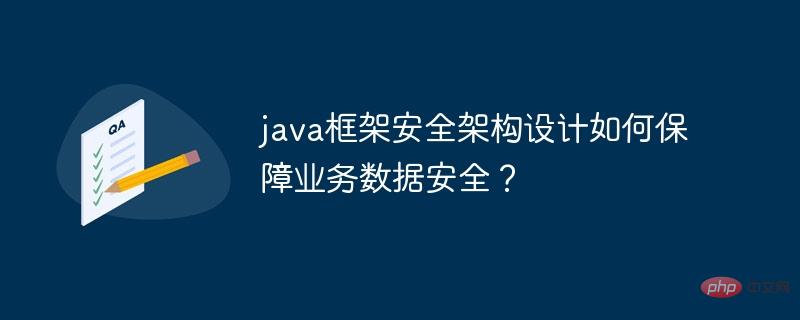
To ensure the security of business data, the Java framework needs to follow the following security principles: Authentication and authorization: control user access to resources. Data encryption: Protects data in transit and storage from unauthorized access. Input validation: Prevent malicious input from causing security vulnerabilities. Security logging and monitoring: Log suspicious activity and monitor applications to respond promptly to attacks.

Java framework security architecture design: the key to ensuring business data security
Introduction
As cyberattacks proliferate, protecting business data from unauthorized access and leakage has become critical. The Java framework provides a range of security features that can effectively protect your applications by following best practices and implementing a robust architecture.
Core Security Principles
Spring Security Architecture
Spring Security is a popular Java security framework that provides comprehensive protection for:
##Most Best Practices
Configuring Security Filters:Use Spring Security filter chains to implement authentication and authorization in your application.
public class WebSecurityConfig extends WebSecurityConfigurerAdapter {
@Override
protected void configure(HttpSecurity http) {
http
.authorizeRequests()
.antMatchers("/admin/**").hasRole("ADMIN")
.antMatchers("/user/**").hasRole("USER")
.anyRequest().authenticated()
.and()
.formLogin().loginPage("/login")
.and()
.logout().logoutUrl("/logout");
}
}Protect form submissions: Protect form submissions from cross-site request forgery attacks using CSRF tokens.
public class WebMvcConfig extends WebMvcConfigurerAdapter {
@Override
public void addInterceptors(InterceptorRegistry registry) {
registry.addInterceptor(new CsrfInterceptor());
}
}Enable security logging: Configure Spring Security to log security-related events.
<bean id="securityAuditorAware" class="org.springframework.security.core.context.SecurityContextPersistenceFilter" /> <bean id="auditManager" class="org.springframework.security.boot.audit.LoggingAuditManager" />
Practical case
Protect REST API: Use Spring Security to protect REST API from unauthorized access.
@RestController
public class UserController {
@GetMapping("/users")
@PreAuthorize("hasRole('ADMIN')")
public List<User> getAllUsers() {
return userService.getAllUsers();
}
}Protect file uploads: Use Spring MultipartResolver and Validator to protect file uploads from malicious file attacks.
@Controller
public class FileUploadController {
@PostMapping("/upload")
public void uploadFile(@RequestParam("file") MultipartFile file) {
if (validator.validate(file)) {
fileService.saveFile(file);
}
}
}Conclusion
By following these best practices and implementing a robust security architecture, you can protect your Java applications from a variety of security threats. It is important to regularly review and update your security measures to keep up with the evolving cyber threat landscape.The above is the detailed content of How does the Java framework security architecture design ensure business data security?. For more information, please follow other related articles on the PHP Chinese website!